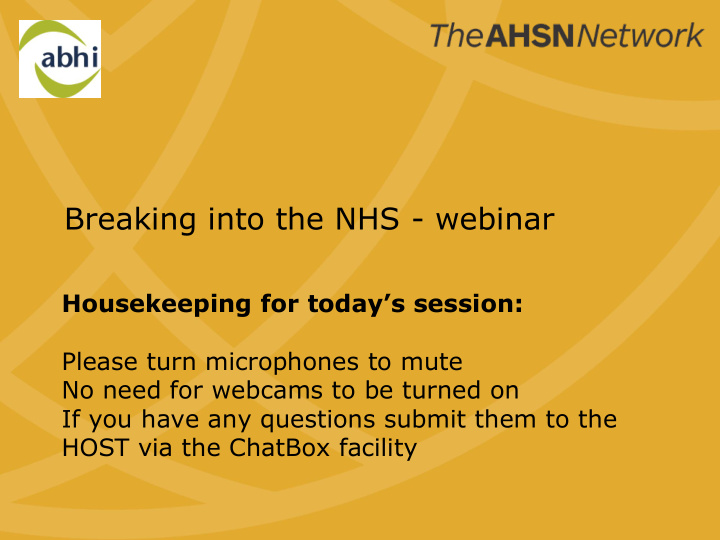



Breaking into the NHS - webinar Housekeeping for today’s session: Please turn microphones to mute No need for webcams to be turned on If you have any questions submit them to the HOST via the ChatBox facility
Richard Phillips Director, Healthcare Policy
Dr Liz Mear Chair, The AHSN Network and Chief Executive, Innovation Agency ( Academic Health Science Network for the North West Coast)
The Innovation Pathway The Innovation Pathway AHSNs help companies & innovators navigate a fragmented landscape 4
AHSNs support innovators and businesses We connect industry with NHS and academic organisations, local authorities and the third sector, AHSNs are catalysts that create the right conditions to facilitate change across whole health and social care economies. We achieve this by: Helping industry to understand and engage with the NHS market, and help align their development programmes to ensure they address clinical and market needs Providing industry and NHS innovators with bespoke services covering the entire innovation pathway - improving health outcomes and contributing to economic growth Working with commissioners to incorporate best practice into contracting Being a single point of contact, helping companies navigate the complex health system Providing advice about issues such as the required evidence base, evaluation methods and gaining access to markets Promoting the Small Business Research Initiative (SBRI) Healthcare programme , NIA programme and run Innovation Exchanges which provide both seed funding and visibility within the healthcare system. Developing the AAR Signposting businesses to our many local partners and regional and national sources of funding 5
Internal market PbR phased in NICE founded CCGs NHS budget doubled
Variation impacts uptake Uptake of an innovation is affected by…. • local practice • local technology • demographics • economies of + + scale • existing contract • skill mix • recruitment • etc. relevance to local fit with local conditions local affordability priorities
Effect of NHS ‘market failure’ Lesser risk Greater risk • • Those in the market New entrants • • Those with strong finance Those with limited funding • • Incremental interventions Disruptive interventions with existing funding without existing funding streams / pathways streams / pathways • • Acute Mental health / community • • Treatment Prevention / early diagnosis • • Short term performance Long term (economic) benefit
Effect of being human • Who is using your product? • The true ‘value’ cannot be seen until the new intervention (technology and or know how) has been validated in the ‘real world’
QUESTIONS?
Market Access approach Product development Market entry Expansion Greater risk technical affordable priority preference Lesser risk technical affordable priority preference
Knowledge Buckets • What “ new decisions ” can be made (that underpin the stated improved outcomes)? • What “ service (re-)configuration ” is needed to enable patients to meet the decision maker? • What “ funding ” (provider +/ - commissioner) supports the service (re-)configuration? • What should “ patients ” be made aware of (to encourage appropriate demand)?
Reasonable assumptions? Affordability • There is a queue for everything. Removing part of a queue doesn’t automatically release resources. Not releasing resources increases cost, albeit for a economic / health outcome gain • Without multi-year financial mechanisms affordability is constrained to a short-term (in-year) horizon. • Contract (+ activity) currencies constrain affordability to single organisations not system wide resource management
Avoiding hazards • Make it ‘resonate’ - Learn to speak their language and describe the opportunity from their perspective • , Don’t do a ‘pilot’ – Undertake an evaluation or – Secure a contract with break clauses • “Where’s the evidence?” - are they really interested?
Bridging the gap Market access briefing - health warning
QUESTIONS?
Summary • The health system (in UK) is not a perfect market • Identifying areas of risk early are highly likely to avoid surprises and disappointment whilst, saving time and effort and in doing so enabling a more cost effective strategy to be developed and enacted • AHSNs can offer support at different stages
What’s next • Innovation surgery – A fully subsidised one hour review – Highlight areas of risk – Identify potential for taking forward – May make specific introductions
Rob Berry robert.berry@nhs.net www.kssahsn.net
Further information www.ahsnnetwork.co.uk www.abhi.org.uk www.sbrihealthcare.co.uk
Recommend
More recommend